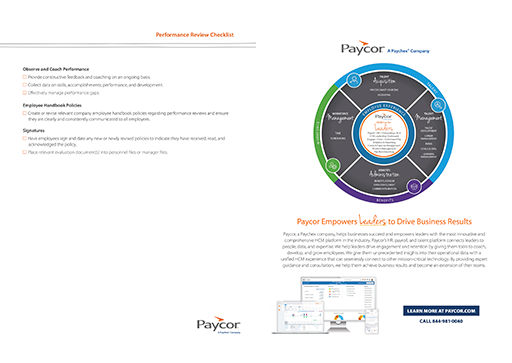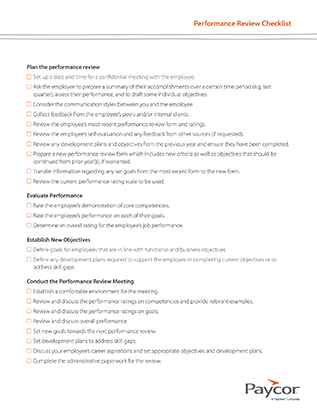Performance Reviews 101
Performance reviews can be a painful process for everyone involved. In fact, Gallup data shows only 2% of chief human resource officers from Fortune 500 companies surveyed strongly agree that their performance management system inspires their employees to improve.
There’s a lot wrong with traditional performance reviews. It takes a whole new mindset to really do it right. We can’t solve all the problems here, but we can start with a performance review checklist.
The goal of the checklist is to help you remember all the performance review to-dos, as well as give you some practical tips on how to make a review go smoothly.
Essential Performance Review Checklist Items
Our free performance review checklist provides a detailed list of the steps you need to take to:
- Plan the performance review
- Evaluate performance
- Establish new objectives
- Conduct the performance review meeting
- Coach and manage the employee
From considering your employee’s communication style to soliciting feedback from peers, all the details are accounted for in the downloadable checklist.
Prepare for the Performance Review of Your Staff
A performance review, when done right, can be a great tool for employee engagement and development.
To get off to a good start, create reminders well in advance so it will not be a surprise for anyone. Even though you may have reviews automatically scheduled a year out (based on starting dates), schedule time before the date to gather feedback and documents related to your employee’s performance.
If there is a rating scale, or a specific form of software, make sure your employee is clear on how to use it.
Use the “plan the performance review” section in the free download for a comprehensive performance review preparation checklist.
Additional Employee Performance Review Checklist Items
In addition to the preparation items above, you need to cross the following performance checklist items off your list to conduct a meaningful, productive performance review.
Feedback from Multiple Sources
When you prepare in advance, you can gather 360 feedback. Inquire about your employee’s project work, if applicable, from peers, internal clients, and other stakeholders to understand how their performance has impacted the team.
An Employee’s Self-Evaluation
Request that your employee keeps a record of accomplishments and can personally assess their own performance in advance of the review, especially as it relates to goals and company objectives. In addition, provide them with a list of employee evaluation questions to get their wheels turning. What accomplishments are you most proud of? What areas do you want to approve? Which goals did you meet? What goals fell short, and why?
Core Competencies
Having an up-to-date job description for each of your employees is a great way to manage expectations of core competencies. You can then use data from 1:1s during the evaluation term (previous quarter, past 6 months, 1 year) to gauge performance according to the description.
Development Plans & Goals
You’ll also want to take a look at the previous review to understand how performance has changed from one evaluation period to the next. Include the development of SMART goals, especially as they relate to larger company objectives, if you haven’t already. Work to understand obstacles in the way of your employee’s movement toward goals, so you can both create a plan forward.
In addition to you performance review checklist, we also have a performance review template you can download and make your own.
Conducting the Performance Review
After you have collected your supporting documents and enabled your staff to also prepare, it is important to select, whether virtual or in-person, a confidential space and time in which your employee can comfortably receive feedback (favorable or unfavorable). As you discuss the details of what’s happened, ensure you are also setting up action plans to address any concerns.
Use this time to also discuss your employee’s career aspirations and set appropriate objectives for future roles. Revise or set fresh objectives, if necessary.
Avoid biases by including a mix of timely feedback, project results and a conversation about goals in every staff performance review. Take time to discuss specific learnings and offer constructive feedback.
Lastly, some organizations require signatures for performance appraisals and reviews. Consult the company policy to familiarize yourself with the specific requirements ahead of time so that you can close the loop.
Use Paycor for Employee Performance Reviews
Our performance review checklist helps ensure a comprehensive review. But if you would like to learn more about how to upgrade and streamline your performance management process, check out Paycor Talent Development. Paycor Talent Development moves beyond the annual performance review by allowing you to create a culture of continuous development.
Performance Review Checklist FAQS
Still have questions? Read on?
Is it Necessary to Evaluate Employee Performance?
Yes. Regular performance evaluations help align individual goals with company objectives, identify areas for improvement, and support employee growth and development.
How Often Should Employee Performance Be Evaluated?
At a minimum, performance should be reviewed annually. However, more frequent check-ins can provide timely feedback and keep employees on track.











